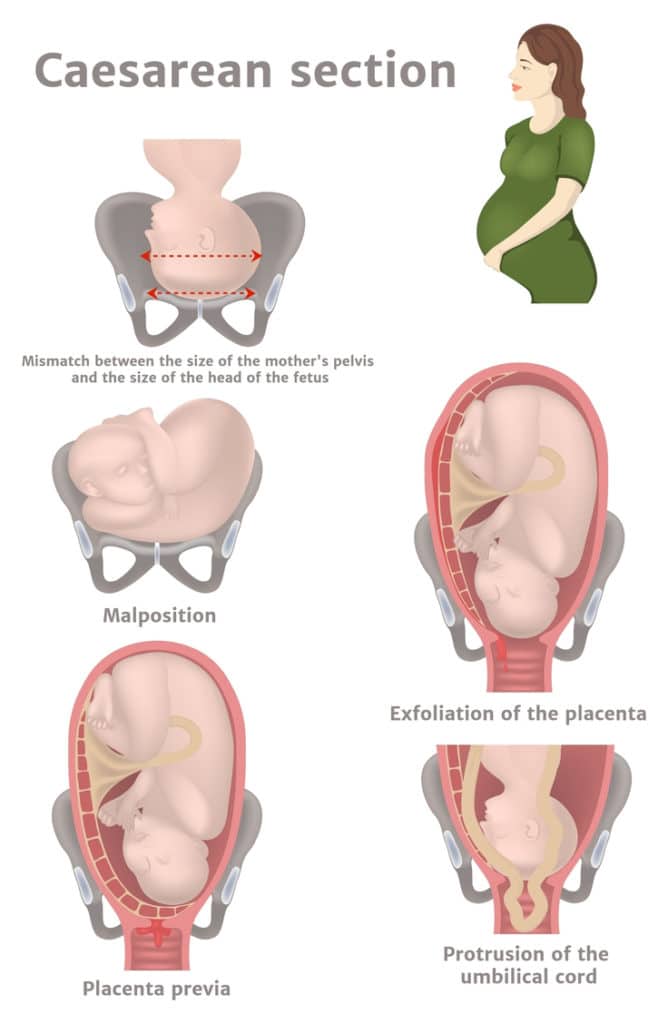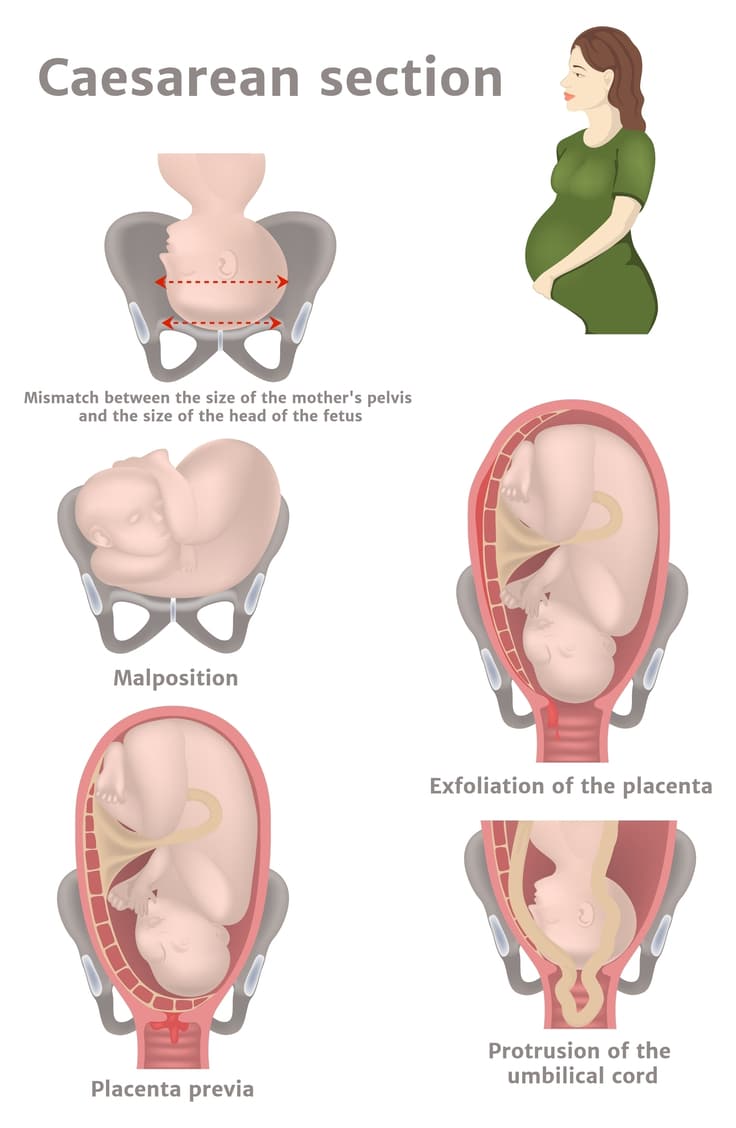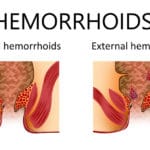Ever wondered if there were any medical reasons for c section? Continue reading to find out why your doctor may have advised you have a caesarean section.
The mode of delivery of a baby is an area of anxiety for some pregnant women. Among Africans, having vaginal delivery is perceived as the ultimate proof of the strength of a woman. Hence, many women look forward to proving their womanhood by having vaginal delivery against all odds.
Unfortunately, pregnancy and labour can be unpredictable and complications could arise at any point that would require an urgent intervention to save the life of the child, mother, or both.
Healthcare workers are interested in your well-being and their utmost desire is to ensure the best outcomes for every pregnant woman who comes in contact with healthcare facilities.
Irrespective of the mode of delivery, having a healthy baby and a healthy mother is ultimately the best outcome for any pregnancy. Cesarean delivery is a life-saving operation that has helped prevent/reduce Maternal and child deaths. No woman should have to die from trying to bring forth a child when a cesarean section could have saved her life.
When your doctor says you need a Caesarean section (CS), you would most definitely get an explanation as to why it is the best option for you and/ or your baby.
Some medical reasons for c section

What is the Cesarean Section (CS)?
Caesarean section, also known as C-section or caesarean delivery, is an operation in which a child is delivered by cutting through the lower abdomen to the womb. Caesarean delivery could be a planned- elective- or unplanned- emergency. Elective means that you and your doctor have decided and agreed that due to certain situation(s), you will have your baby via CS and you prepare before the set date.
You don’t wait to go into labour before you go to the hospital, instead, you have a set date for the surgery. This date is set anytime from the end of the 37th week when your baby is term or earlier if there is a compelling reason the baby needs to be delivered prematurely.
Why would your doctor recommend a Caesarean section?
When your doctor examines you and requests blood tests and scans, certain observations indicate that CS would be the best option for you. Some of these are from you, your baby(ies), or both.
Reasons that have to do with the child
In circumstances where the child is born through the vagina will expose that child to injury, disease, or death, a cesarean delivery is necessary. These include
- Breech presentation: Close to the 9th month of pregnancy, your baby normally is supposed to turn in the womb with the head down and facing the vagina. If any other part of the body is facing the birth canal such as the buttocks or legs, that is a breech presentation. Delivering a breech baby through the vaginal route carries a much higher risk than Cesarean delivery.
Many babies with breech presentation stand a risk of sustaining an injury during delivery. This may or may not be reversible. A baby can have a nerve injury in any of the limbs during a breech delivery which will limit movement in that limb or even cause permanent paralysis. A baby presenting with the feet is at risk of having their cord (which is attached to the placenta) compressed by the aftercoming body and head. This cuts off the blood supply to the child with subsequent asphyxia.
- Babies with malformations such as spina bifida and Siamese twins cannot be delivered vaginally if the child is to survive.
- The presence of more than 2 babies (triplets, quadruplets, quintuplets, etc.) is an indication for a planned Cesarean delivery. The mother may be exhausted from pushing the first 2 and other babies stand the risk of being deprived of oxygen for a long period. If this happens, the child can have thereby had cerebral palsy or may die during or shortly after delivery.
- Abnormally high or low heart rate in the baby. This indicates that the baby is in distress, may not survive the rigors of going through the stages of labor, and needs to be delivered as soon as possible. During antenatal care and labor, the baby’s heart rate is checked to ensure it is beating properly and at a normal range. If it is so faint that it can hardly be heard, too slow or too fast, that is a reason for an urgent c-section to avoid death in the womb.
- Babies are suspected to be bigger than normal based on estimation of weight through ultrasound scan or clinical examination. A baby is said to be macrosomic if they are heavier than 4kg. babies (macrosomia). A big baby passing through the vagina stands the risk of being trapped halfway out of the vagina even with an episiotomy (a cut in the vagina to make more room). This can cut off the oxygen supply to the brain and if it lasts more than a few seconds can cause abnormal growth and developmental milestones (cerebral palsy).
- A precious baby: A baby that is conceived through assisted reproductive techniques, after many years of trying to conceive or the 1st to be carried to term after recurrent miscarriages are regarded as a precious baby. Your doctor may recommend an elective CS to avoid eventualities that may arise during labor and vaginal delivery.
Has to do with the mother
- Presence of a scar in the womb: Whether the scar is due to a previous c-section or a surgery in which cuts were made on the uterus such as fibroid removal, having a vaginal delivery closely following the operation can put so much pressure on the womb and make it to rupture. This causes excessive bleeding that is often fatal. More than one cesarean delivery is also a reason for elective CS for the same reasons highlighted above.
- Mother with a heart condition or a respiratory disease that would be worsened by allowing the mother to go through labor.
- Growth in the lower part of the womb, vagina, or vulva: A growth in the vagina, neck of the womb (cervix), or vulva can obstruct the exit of the baby during delivery. These include uterine fibroids, cancers, large vaginal warts, or abnormally formed vagina with 2 openings in the mother.
Both
- The head of the baby is bigger than the mother’s pelvis: This is called cephalopelvic disproportion (CPD). It often happens when the mother has a small pelvis but the baby takes after the huge father. The baby may not be too big but the mother’s pelvis is small relative to the baby’s size.
- Abnormal placental location: If the placenta is close to the cervix (placenta previa), it can obstruct the baby’s exit and/or bleed excessively during vaginal delivery. This can cause the death of either mother, child, or both.
Some people have gone ahead to have a vaginal delivery after the doctor had recommended a CS albeit through excruciatingly painful double episiotomies and the risk of having a special needs child (cerebral palsy). It might also be through assisted vaginal delivery using instruments such as vacuum or forceps. These are helpful but have a high risk of injury to both mother and child.
Cesarean delivery has its risks, and so does vaginal delivery when there are indications for a CS. Would you rather risk having a child born with an injury that might culminate in malformations for the rest of that child’s life, a child with cerebral palsy that could have been prevented, or would you rather go for the safer option with minimal risk of injury?





